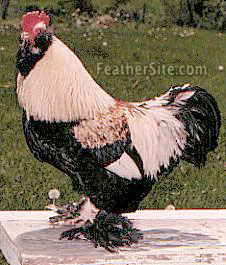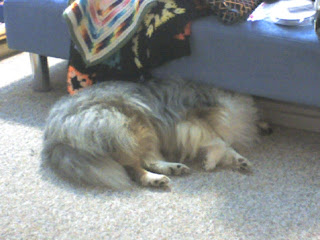Have you ever seen a chicken run? I don’t mean the animated flick, but an ACTUAL chicken running full-bore? Picture a body-builder on Venice Beach. All buffed up, with that muscle-bound “jock” walk. Then picture that silhouette, but with feathers! That’s the profile of a Brahma chicken. Brahmas are big, gentle chickens who strut about as if they own the barnyard. Our Brahma cockerel kinda resembles that giant Stay Puft Marshmallow Man from “Ghostbusters”! Watching them walk about is a hoot, as they stalk around looking all “large & in charge”!! 8-)
 |
| "Marshmallow Man" |
My post today builds on my previous post on “Jungle Chickens”. We were forced to “exile” our big fighting breed cockerel “Big Red” from the henhouse because he was a bully. Big Red is quite large, & he knows it. After our Brahma cockerel was killed, we exiled both Big Red & Big White (I know, creative names, huh?) to the great outdoors. We figured our hens would be thrilled to lose a couple of roosters. But we underestimated the magnetism of Big Red.
There is a rip in the netting over our chicken yard that can no longer be repaired. It has been repaired so many times that there simply is not enough net left to repair! Since we had reached the point where the chickens wouldn’t be going outside due to the cold, we left the net alone & planned to replace it after the henhouse door was closed for the winter. Problem is, we didn’t reckon on the determination of those darned hens! Next thing we know, a couple of hens have “broken out” to be with Big Red!
 |
| Plotting Hens!! |
Here’s the dilemma: while my sis & I are working our full-time jobs, our hens have all day long to figure out how to “force” the henhouse door leading to the chicken yard. Chickens aren’t very bright, but they ARE persistent, & they have the advantage of unlimited time in which to work their covert machinations! Last year, they pecked at their wooden door until they wore it down so far that the bottom broke off, & out they ran into the snow-covered yard! This time, we arrived home in darkness only to find a chorus line of hens, spotlighted by our headlights, running loose in the yard.
There is no electricity out on our 4-acre yard where the “Jungle Chickens” now live, so it is virtually impossible to capture them in the dark. Our naive chickens have no experience with predators, so they don’t understand that they must fly up into trees or find other secure perches in order to remain safe. The end result has usually been that our “problem roosters” disappear, but now our egg-producing hens are at risk too! The only good thing is that Big Red is a large rooster, & he will fight to keep those hens safe! Fortunately, they decided to roost in some of our old barrels, where they could all share body heat & remain under cover.
We thought that Red had only seduced a couple of the hens away from the henhouse, but last Friday we discovered that 2 of our BEST hens had followed his siren song -- our Buff Orpington (creatively named “Buff”) & our ONLY Brahma hen (named “Honeychile”)! I spent a good chunk of Sunday afternoon trying to catch these 2 hens to get them back into the safety of the henhouse. So you could say that I know A LOT about chickens running!
 |
| Mariah, the Aussie Queen |
Herding dogs aren’t a lot of use with chickens, although they’re AWESOME with sheep! Herding drive is a modified prey drive, & a dog’s prey drive is almost always “activated” when a chicken flaps her wings. So it is usually not safe to use a herding dog to herd chickens. My sis had an awesome chicken herding dog, Tucker, but he died 2 years ago. Currently, we don’t have a dog we can trust with the chickens.
If you don’t have another person or a dog to help you “herd” an escaped chicken back into the henhouse, one of the best tools you can use is a landing net. Yes, I said “landing net” -- as in the kind you use to land salmon or trout while fishing! These nets are the perfect tool to drop over a chicken, flip them up into the net, & then carefully remove them from the net to place them back in the henhouse. Chickens have very strong claws with long nails, but most landing nets are very strong, especially if you purchase one intended for larger fish like salmon. I always look for landing nets at garage sales, so that I don’t have to purchase a brand new one when my current one dies. You can also use a blanket or a beach towel & throw it over the chicken, but both of these tools have the disadvantage of being opaque, making it tough to grasp the chicken firmly. Truly, the best tool out there is a landing net.
I thought I had it handled. I would go out with the net, capture the hens, & put them back into the henhouse. I’ve done this so many times that it seemed like a no-brainer, but I didn’t consider one small detail. I currently have this little neurological issue that has paralyzed half of my face. Due to this, my eye runs with tears whenever I am outside in the cold, blurring my vision. Add to this, chickens can RUN! And boy, do they ever run when you try to net them! I’ve netted chickens many times, but this time I just COULD NOT get the net OVER the hen! One blurry eye equals NO distance perception, so every time I dropped that darned net, it landed just short of the hen! I was especially frustrated by little Honeychile, who seemed determined to run away from me! She looked like a little white bodybuilder hightailing it outta there! Aargh! The end result after 3 hours of work is that I didn’t catch a SINGLE one. Oh, except for Big Red, who I caught THREE times!
 |
| Mixed-Breed Rooster (NOT Big Red!) |
Apparently Red isn’t scared of me or the net! This should come as no surprise, since Big Red runs straight at the front of my van every single morning when I’m leaving for work! For a chicken, Red is pretty brave, so I dropped the net over him, picked him up, & put him back on the ground again. After the third time, I lifted him up into my arms & carried him around the yard for a while. I thought it was a good idea to see how his development was progressing, & it is always good to do some work taming your roosters. You don’t want your roosters getting so territorial that they attack you & everyone else who visits your yard!
From holding him, I determined that Red is still a cockerel & doesn’t have the leg spikes of a rooster quite yet. So it’s pretty safe to say that Red didn’t kill our Brahma cockerel, since roosters usually kill with their spikes. In fact, I discovered that Big Red is actually quite tame. He allowed me cuddle him & ruffle his hackles (neck feathers), & even let me handle his feet & check his spikes. I carried him all over the yard, & the only time he squawked was when I put him face to face with our lead sheep, Carmel.
Even though I didn’t catch a SINGLE hen, I still consider the afternoon a partial success. If we can keep Big Red reasonably tame, & he survives life as a Jungle Chicken, perhaps we can co-exist with him living on the “big yard”. In fact, I think I’m genuinely starting to like him.
So.... That's the story of my latest chicken run! Hopefully it brought a smile to your face. I'm still aching all over from chasing chickens all over creation! But I still say that the worst day chasing chickens is better than the best day locked inside an office! Have a great day!





























